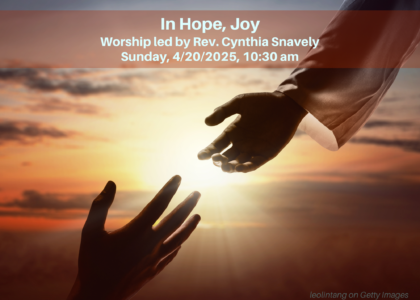Please click the link to watch Rev. Cynthia Snavely’s video recording of this sermon.
According to Christian scripture in the Gospel of John, “On the evening of that first day of the week, when the disciples were together, with the doors locked for fear… Jesus came and stood among them and said, ‘Peace be with you!’… The disciples were overjoyed when they saw the Lord,” (John 20:19-20 NIV).
Their teacher and leader had just been arrested, tried and hanged, naturally they were afraid. They might be next. But then they saw Jesus among them and their fear turned to joy.
The empty tomb comes late to the story of Easter. The Apostle Paul, whose letters are some of the earliest writings in what Christians call the New Testament, simply says, “He was buried … he was raised up on the third day according to the scriptures, and he appeared to Cephas, then to the twelve,then he appeared to more than five hundred brothers at once, the majority of whom remain until now, but some have fallen asleep. Then he appeared to James, then to all the apostles, and last of all, as it were to one born at the wrong time, he appeared also to me.” (I Corinthians 15:4-8NIV). Paul thinks of his own vision of Jesus as not unlike the appearances to the other disciples right after Jesus’s death.
Perhaps you, like me, have had people tell you after the death of their loved one something like this: “I saw him. He was sitting in his favorite chair. Then I knew everything was alright.”
Are such visions a reality outside of ourselves or something created by our own minds? And does it matter? The point is that they offer us comfort and reassurance. All is well.
In the blurb for this week’s service, I quoted a hymn by Septimus Winner:
“Soft as the voice of an angel,
Breathing a lesson unheard,
Hope with a gentle persuasion,
Whispers her comforting word.
Wait till the darkness is over,
Wait till the tempest is done,
Hope for the sunshine tomorrow,
After the shower is gone.
“Whispering Hope
O how welcome thy voice,
Making my heart in its sorrow rejoice.”
Another verse of the hymn sings,
“Hope as an anchor so steadfast,
Rends the dark veil for the soul,
Whither the Master has entered,
Robbing the grave of its goal.
Come then, O come, glad fruition,
Come to my sad weary heart,
Come, O Thou blest hope of glory,
Never, O never depart. [Chorus]
O blessed Hope!
“Whispering Hope
O how welcome thy voice,
Making my heart in its sorrow rejoice,” (Whispering Hope | Hymnary.org).
Note that Winner very explicitly says here that the Master is not in the grave, but within his soul, his heart.
Growing up in the community of Kochenderfer’s Evangelical United Brethren Church, every Easter we sang a hymn that ended with this chorus:
“He lives, he lives Christ Jesus lives today!
He walks with me and talks with me along life’s narrow way.
He lives, He lives, salvation to impart!
You ask me how I know He lives? He lives within my heart!” (He Lives lyrics by Alfred H. Ackley – original song full text. Official He Lives lyrics, 2025 version | LyricsMode.com).
Those disciples of Jesus who were locked into a room for fear saw, felt, knew Jesus’s presence among them and they were emboldened. They had hope. They opened the door and went out. The Book of Acts says, “They devoted themselves to the apostles’ teaching and to fellowship, to the breaking of bread and to prayer. Everyone was filled with awe at the many wonders and signs performed by the apostles. All the believers were together and had everything in common. They sold property and possessions to give to anyone who had need. Every day they continued to meet together in the temple courts. They broke bread in their homes and ate together with glad and sincere hearts, praising God and enjoying the favor of all the people. And the Lord added to their number daily….” (Acts 2:42-47a NIV).
Notice that twice the writer refers to breaking bread together. The New Testament scholar Norman Perrin, in his book Rediscovering the Teachings of Jesus, says that one of the key features of Jesus’s ministry was that he ate with people to whom others would not give the time of day, much less sit down with at the same table; prostitutes who sold themselves for money and tax collectors who were willing to collect money for Rome, for the oppressor.
Perrin then says that the early Christian communal meal was a continuation of this regular practice of Jesus’s ministry.
He writes, “The central feature of the message of Jesus is, then, the challenge of the forgiveness of sins and the offer of the possibility of a new kind of relationship with God and with one’s fellow (person). This was symbolized by a table fellowship which celebrated the present joy and anticipated the future consummation; a table-fellowship of such gladness that it survived the crucifixion and provided the focal point for the community life of the early Christians and was the most direct link between the community and the pre-Easter fellowship of Jesus and his disciples.”
They went from hiding in a locked room out of fear to openly eating together with all who came into their communities. They went from fear to hope to joy.
Today many of us are afraid. Some of our congregations are locking their doors during worship. Some are posting safety monitors to walk their grounds during meetings. Some of us are looking at our social media and scrubbing it of anything we fear may make us targets.
We have seen neighbors picked up by the authorities and sent to a prison in another country described as notorious for its violence. We have heard our President say the “homegrown” are next.
We have seen other neighbors lose their jobs. We have seen laws and programs that we thought would keep us safe undone.
What can give us hope in this time? How can we find some joy?
In this week’s Braver/Wiser email, Unitarian Universalist minister Rev. Verdis LeVar Robinson tells us how he does. He writes:
“When I was growing up as a Holiness Pentecostal preacher’s kid, I always looked forward to Easter time.In addition to the Easter Egg Hunt and the multigenerational program during the service that always included a play, the music was the best part. Every year, the one song that all the program participants sang together was ‘Can’t No Grave Hold My Body Down.’
“The version we sang as a multigenerational urban Black choir was taught by rote, and its arrangement was never on sheet music. Never. It was a call and response song that from beginning to end, was spirited with fast foot-stomping and hand-clapping—in true Pentecostal fashion. The fire, the joy, the celebration… I looked forward to singing it every year.
“When I became a UU, that song was never sung. In fact, most songs aren’t in the Pentecostal style, and definitely not about graves holding bodies. However, in recent times, this song has come back to me. Why is it resurfacing after all these years, when my theology has transformed as well as my faith?
“In an era of certain oppression, living our values calls me to resistance. Fear of harm, fear of death, fear of erasure, forced into closets and into stealth mode: living our values calls us to action. The voice and guitar playing of Sister Rosetta Tharpe, in her 1956 rendition of ‘Can’t No Grave Hold My Body Down,’ inspires me to not fear harm when resisting oppression.
“For nearly a hundred years, the triumph of Jesus’s death has inspired Black Pentecostals to sing with vigor that ‘We will rise,’ as they believed Jesus did. He suffered for his beliefs; he resisted, he loved, and he died. It inspires me to not fear death when resisting erasure.
“We will not be forced back into closets or forced to engage our stealth mode. Why? Because can’t no grave hold our bodies down! They will try us, but in love, we will rise,” (Can’t No Grave Hold My Body Down | Braver/Wiser | WorshipWeb | UUA.org).
I was reminded by Rev. Robinson’s words of the last verse of Maya Angelou’s poem, “Still I Rise.”
“Leaving behind nights of terror and fear
I rise
Into a daybreak that’s wondrously clear
I rise
Bringing the gifts that my ancestors gave,
I am the dream and the hope of the slave.
I rise
I rise
I rise,” (Still I Rise | The Poetry Foundation).
We as Unitarian Universalists have a heritage of ancestors who can live in our hearts to embolden us. Yes, Jesus. But also Michael Servetus, Francis David, Norbert Capek, Viola Liuzzo, James Reeb. They died, but they live on in us. Their spirits embolden us. In the midst of our fear, they give us hope and yes, even joy.
Please join with me in a time of meditation using words from UU minister Victoria Weinstein. “The stone has got to be rolled back from the tomb again and again every year.
Roll up your sleeves.
“He is not coming back, you know.
He is not coming back unless it is we who rise for him
We who lay healing hands on the reviled and rejected like he did
on his behalf—
We who rage for righteousness in his insistent voice
We who love the sinner, even knowing that ‘the sinner’ is no farther off than our own heartbeat.
“He will not be back to join us at the table
To share God’s extravagant banquet
God’s love feast, all are invited, come as you are
And so it is you and I who must feast for him
Must say the grace and break the bread and pass it to the left
and dish up the broiled fish (or pour the wine) and pass it to the right.
And treat each one so tenderly
as though just this morning (they) made the personal effort
to make it back from heaven, or from hell
but certainly from death
to be by our side.
“Because if by some miracle (and why not a miracle?)
He did come back
Wouldn’t he want to see us like this?
Wouldn’t it be a miracle to live for just one day
So that if he did, by some amazing feat
come riding into town
He could take a look around and say
‘This is what I meant!’
“And we could say
it took us a long time…
but we finally figured it out.
“Oh, let us live to make it so.
“You are the resurrection and the life.”
Amen.
If you’ve appreciated this sermon, please text to give or visit our Give Now page to support the UUCSH Share the Plate efforts to assist those in need.

